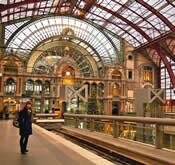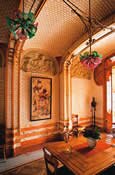Inflight Magazine of Brussels Airlines
Welcome to the Inflight Magazine of Brussels Airlines
Restored glory
The rebirth of art deco masterpiece Villa Empain in Brussels earlier this year added another jewel to Belgium’s garland of historical buildings. Guy Dittrich applauds the country’s attempts to nurture its architectural heritage
 In the heart of the Flemish province of Limburg, about an hour’s drive east of Brussels, is Bokrijk – a magical experience where historic villages are brought to life. But Bokrijk isn’t about replication; each building was meticulously dismantled and brought here in the 1950s, from timber-framed homes to simple thatched farmsteads and, of course, a windmill or two. The experience is not unlike that of a period drama; voices cry out as animals are rounded up, and errant school children attempt to avoid chores. Each winter there’s an evening programme to complement the summer opening of the museum, while the grounds, arboretum and playground are open all year.
In the heart of the Flemish province of Limburg, about an hour’s drive east of Brussels, is Bokrijk – a magical experience where historic villages are brought to life. But Bokrijk isn’t about replication; each building was meticulously dismantled and brought here in the 1950s, from timber-framed homes to simple thatched farmsteads and, of course, a windmill or two. The experience is not unlike that of a period drama; voices cry out as animals are rounded up, and errant school children attempt to avoid chores. Each winter there’s an evening programme to complement the summer opening of the museum, while the grounds, arboretum and playground are open all year.
This appreciation of architectural heritage hasn’t always been the case across the country, however. It’s true that the Flemish cities of Bruges and Ghent are well established on the architectural trail, with great gothic and medieval buildings, but while such genres are also found in Brussels, the capital is beleaguered with a fragmented urban landscape. Whole neighbourhoods have been destroyed to make way for new buildings, and with them many fine examples of the city’s architecture.
Today, though, Brussels’ patrimony is under the auspices of Charles Picqué, minister-president of the Brussels-Capital Region. Since the region was established 20 years ago “a great deal has improved,” says Picqué’s advisor Pascale Ingelaere, and the excesses of the past will be avoided by the implementation of stronger legislation. There isn’t an active restoration programme per se, but grants of up to 80% towards the costs of such works are available to private owners. And should a building be on the list of 3,000 or so maintained by the Monuments and Sites Department, planning restrictions are quite onerous.
Villa victory
 Amongst the best examples of a near- perfect restoration of a heritage building in conjunction with the Brussels-Capital Region is the recent refurbishment of Villa Empain. Commissioned in 1930 by Baron Louis Empain, son of a wealthy industrialist, the interiors feature beautiful art deco detailing and rich tropical wood panelling. Now, the careful restoration under Francis Metzger of Ma2 has delivered a polished granite façade typical of the architectural genre. Faced with many challenges given the dilapidated state of the building, Metzger went to extraordinary lengths to find the best craftspeople and source replacement materials – and the result is stunning.
Amongst the best examples of a near- perfect restoration of a heritage building in conjunction with the Brussels-Capital Region is the recent refurbishment of Villa Empain. Commissioned in 1930 by Baron Louis Empain, son of a wealthy industrialist, the interiors feature beautiful art deco detailing and rich tropical wood panelling. Now, the careful restoration under Francis Metzger of Ma2 has delivered a polished granite façade typical of the architectural genre. Faced with many challenges given the dilapidated state of the building, Metzger went to extraordinary lengths to find the best craftspeople and source replacement materials – and the result is stunning.
Brussels’ art nouveau treasures, meanwhile, are numerous, generally well preserved and well documented. The Horta Museum, former home of the architect Victor Horta, is one of the best examples of his work in this field. What’s more, the recent purchase of the next-door property – itself a fine example of art nouveau by one of Horta’s contemporaries, Jules Brunfaut – will allow the whole of Horta’s building to be made public. The development of this new extension is a structurally complicated affair expected to take at least three years.
Dynamic dialogue
 Olivier Bastin, recently appointed master architect for Brussels, sees the architecture of the city as three strands that need to be balanced. On one side are the true patrimony cases of pure restoration, while on the other are the contemporary structures needed to reflect Brussels’ role as a 21st-century city. In between are the existing patrimony buildings that need to develop a “dialogue with the city”, says Bastin, who is also at pains to point out that his remit is “not to redesign Brussels”. On the contrary, such dialogue keeps buildings relevant and usable, avoiding the fear Ingelaere has for Brussels developing into a “museum city”. Bastin’s own practice, l’Escaut, provides a good example of a sensitive, modern intervention in the Cheval Noir artists’ complex alongside the canal. On a site beside a former brewery, l’Escaut has created a new accommodation block, its angular, zinc-clad faces clearly identifiable from the old building.
Olivier Bastin, recently appointed master architect for Brussels, sees the architecture of the city as three strands that need to be balanced. On one side are the true patrimony cases of pure restoration, while on the other are the contemporary structures needed to reflect Brussels’ role as a 21st-century city. In between are the existing patrimony buildings that need to develop a “dialogue with the city”, says Bastin, who is also at pains to point out that his remit is “not to redesign Brussels”. On the contrary, such dialogue keeps buildings relevant and usable, avoiding the fear Ingelaere has for Brussels developing into a “museum city”. Bastin’s own practice, l’Escaut, provides a good example of a sensitive, modern intervention in the Cheval Noir artists’ complex alongside the canal. On a site beside a former brewery, l’Escaut has created a new accommodation block, its angular, zinc-clad faces clearly identifiable from the old building.
Best of both worlds
The KVS theatre on Lakensestraat in central Brussels, meanwhile, is a building in dialogue with itself: a wonderful new concrete bowl of an auditorium has been inserted within the ornate Flemish neo- Renaissance exterior. On a larger scale are the underground railway platforms beneath Antwerp Centraal station. A huge tunnel was driven under the station, allowing its transformation into a route for the high-speed rail network across Europe.
The fin de siècle excesses of the original glass-topped train shed are matched by the effortless simplicity of architect Jacques Voncke to allow daylight to flow right down to the deepest platforms.
No review of Belgium’s architectural heritage would be complete without a mention of the ‘never to come down’ scaffolding on Brussels’ Palais de Justice. The gilded dome was finally revealed a few years ago, much to the delight of citizens and tourists, but the rest of the scaffold has been up for so long that it now needs its own refurbishment. There seems to be an end in sight, however. Ingelaere says, “We expect to have at least some of the scaffold down within a year,” while an international design competition, Brussels Courthouse: Imagine the Future, is also promising. A decision about the exact use for the building has yet to be made, but judging will take place by the end of the year.
In Belgium, developing coordinated polices across federal, regional and local administrations is a tall order made more complicated by the vested interests of those either side of the language divide. In fact, it’s a wonder so much of the country’s architectural heritage has been saved. And there’s no better time to experience it; the latest projects were mostly initiated long before the current global financial crisis, and there may well be a lull before such a wealth of opportunities come around again.
FR Conservation du passé
Guy Dittrich acclame les efforts de la Belgique en matière de protection de son patrimoine architectural
A une heure de route à l’est de Bruxelles se trouve Bokrijk, où des acteurs font revivre l’esprit des villages historiques flamands. Mais cette valorisation du patrimoine architectural belge n’a pas été mise en oeuvre partout avec le même talent. Dans la capitale notamment, qui a assisté à la destruction de quartiers entiers. Mais les choses changent, et la Région de Bruxelles-Capitale subsidie parfois jusqu’à 80% des coûts de travaux de rénovation. La restauration de la Villa Empain, de l’époque art déco, en est un exemple récent.
Olivier Bastin, nouveau maître architecte pour Bruxelles, pense qu’il faut équilibrer deux éléments. D’un côté, le patrimoine pur, de l’autre, les structures contemporaines nécessaires pour entrer dans le 21ème siècle. Les bâtiments doivent développer un « dialogue avec la ville », explique Bastin, pour qu’ils continuent à y avoir leur place. Ainsi, le bureau de Bastin, l’Escaut, a réalisé une intervention sensible pour le complexe de logements-ateliers d’artistes Cheval Noir ; sur un site proche d’une ancienne brasserie, l’Escaut a créé un nouveau bloc de logements relié à l’ancien bâtiment. De même, pour le théâtre KVS, rue de Laeken, un auditorium en béton a été inséré à l’intérieur du bâtiment flamand, de façade néo-renaissance. Et puis, il y a le Palais de Justice de Bruxelles. L’échafaudage y est resté tellement longtemps que c’est lui qui aurait besoin d’être remis en état… Mais il semble que la fin du chantier soit en vue : un concours international a été lancé afin de développer une vision de la fonction future du bâtiment.
Finalement, c’est un miracle qu’un tel d’héritage ait pu être sauvé en Belgique, où les politiques de rénovation urbaine sont plus compliquées du fait de la division linguistique. Ne manquez pas
NL Zorg dragen om het verleden
Guy Dittrich steunt de pogingen om het Belgisch architecturaal patrimonium nieuw leven in te roepen
Bokrijk ligt op een uurtje rijden naar het oosten vanuit Brussel. Hier brengen acteurs het Vlaamse oude dorpsleven opnieuw tot leven. De zorg om het architecturale Belgische erfgoed België werd niet overal even nauw genomen; in Brussel werden hele buurten vernietigd. Maar er is verandering op komst; in Brussel Regio wordt tot soms 80% van de kosten voor dit soort werken gesubsidieerd. De herinrichting van de art deco Villa Empain is een recent voorbeeld van restauratie.
Olivier Bastin, de nieuwe Brusselse hoofdarchitect, wijst op twee zaken die moeten worden uitgebalanceerd. Enerzijds hebben we de zuiver patrimoniale gebouwen en anderzijds de hedendaagse 21ste eeuwse bouwwerken. Bestaande gebouwen moeten een “dialoog met de stad” aanknopen, aldus Bastin. Het ontwerpbureau van Bastin voerde zo werken uit in het artistiek complex Cheval Noir; op een site nabij een voormalige brouwerij richtte het een nieuw accommodatieblok in dat vast hangt aan het oude gebouw. Een gelijkend project: in het KVS theatergebouw in de Lakensestraat werd een betonnen auditorium geïntegreerd in het Vlaamse neonrenaissancistische gebouw. En dan is er het Brusselse Justitiepaleis. De steigers lijken er al zo lang te staan…. Het einde lijkt nu in zicht met een wedstrijd die een visie zal vaststellen voor de toekomst van het gebouw.
Eigenlijk is het een wonder dat er zoveel architectuur is bewaard gebleven nu het uitwerken van het restauratiebeleid in België complexer is dan ooit door het talenverschil.
Leave a Reply
